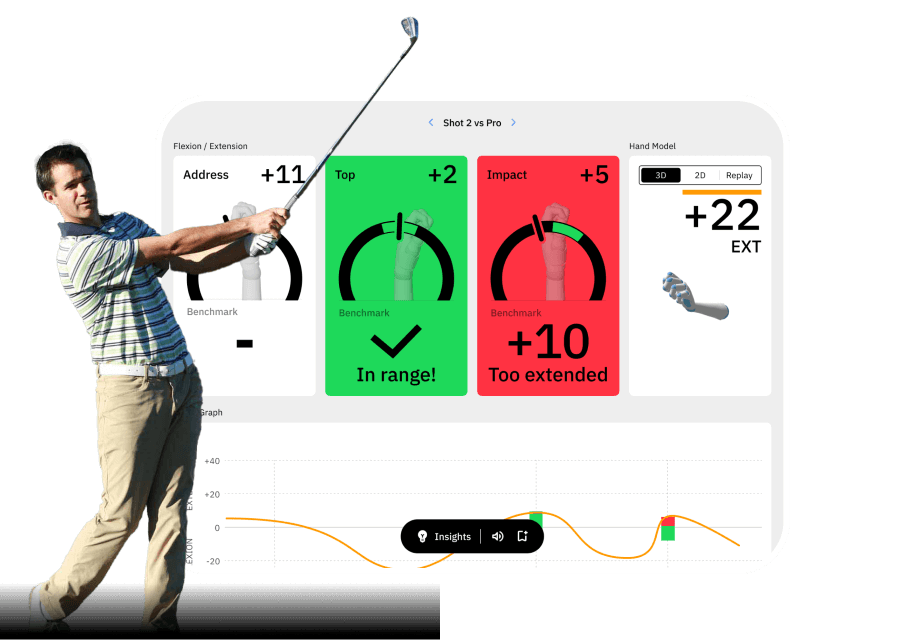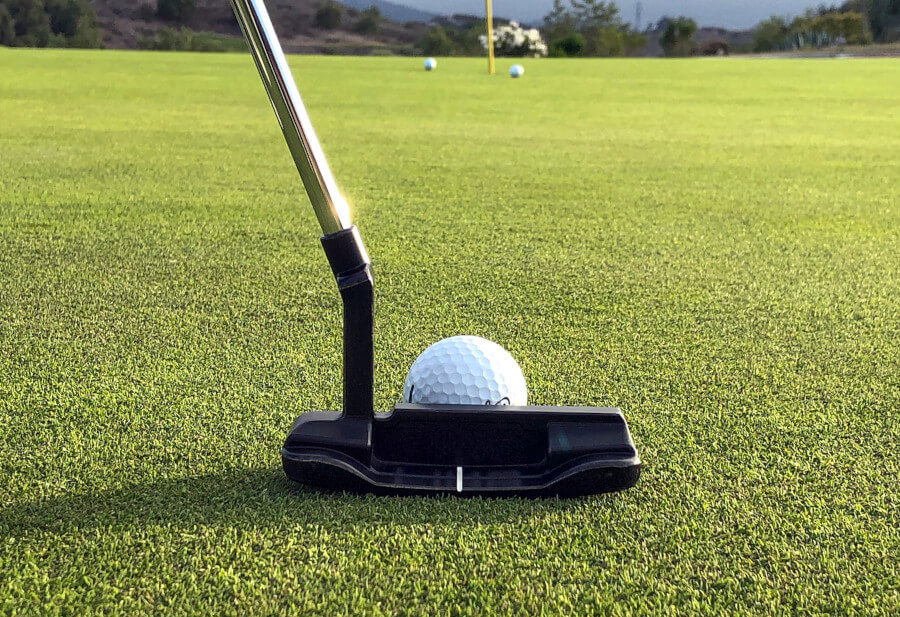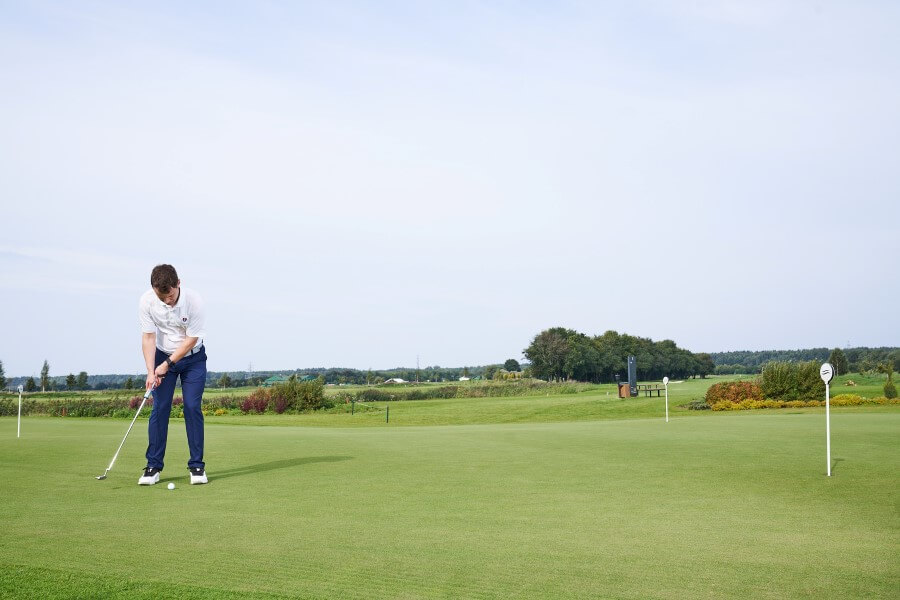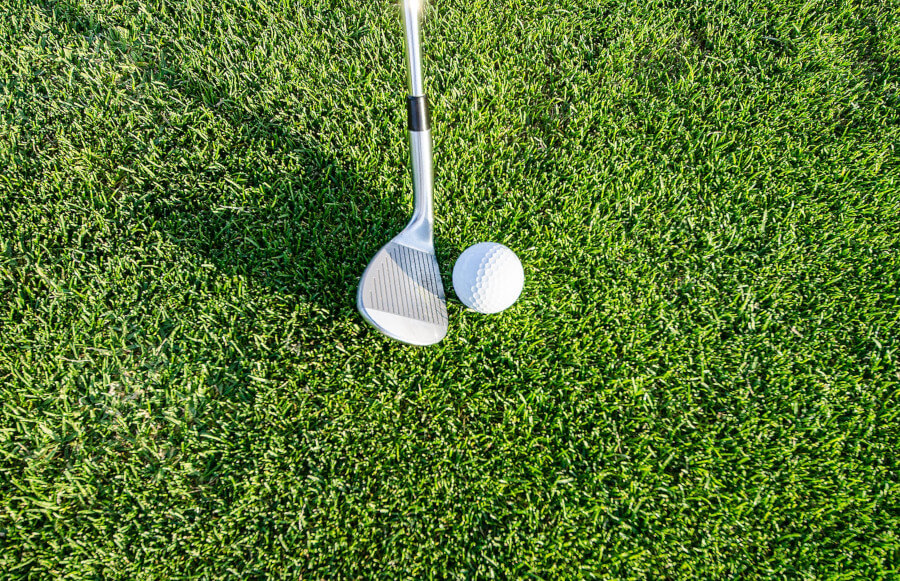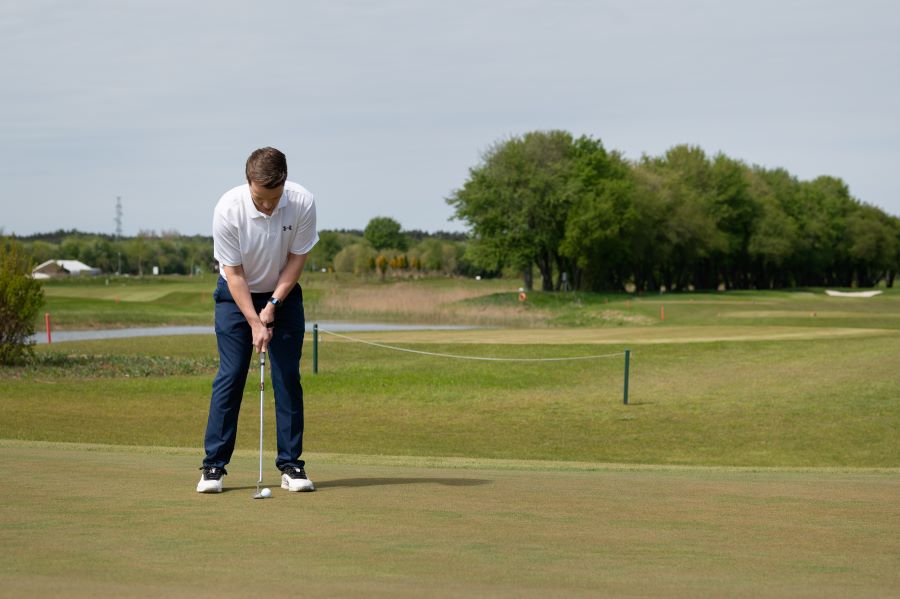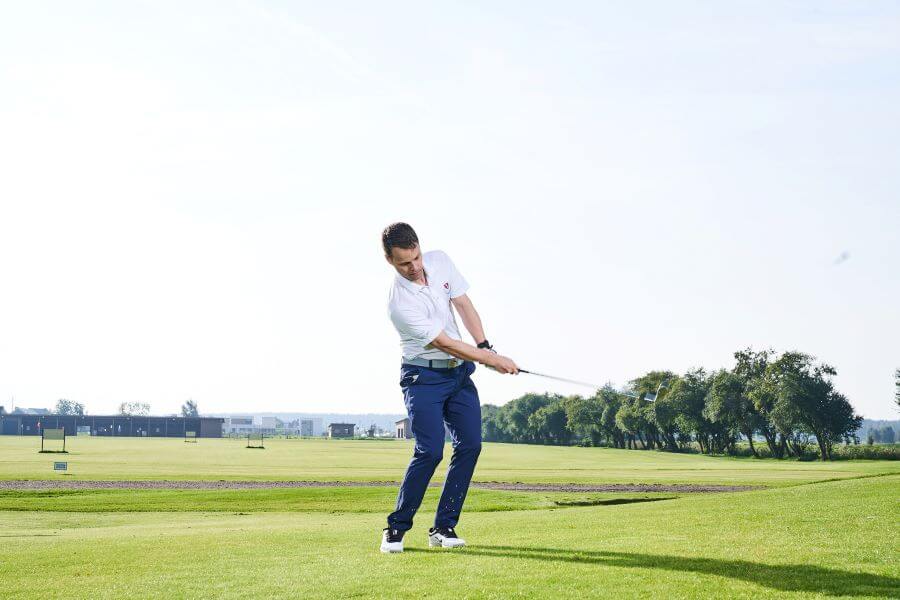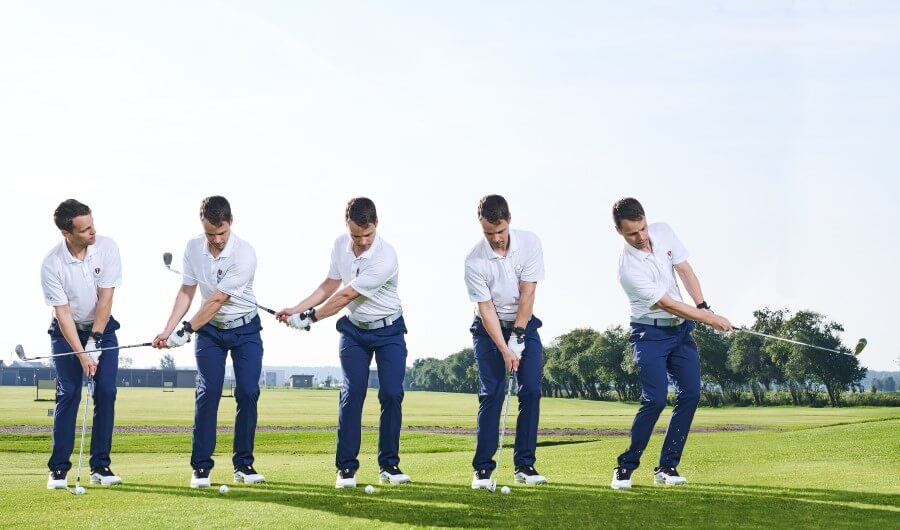12 Pitching Tips to Improve Your Short Game (Become a Pitching Pro)
Scoring your best in golf is highly influenced by how sharp your short game is.
Shots from 100 yards and in make up 60% to 65% of all the shots you take in a round. Pitch shots make up a big part of those shots.
Today I will share with you some of my best tips on how to become a pro at pitching.
Like with all parts of your game, there are no quick, short-cut type tricks to suddenly become a dramatically better pitcher of the ball. It takes an understanding of proper technique and lots of practice. Plain and simple.
Golf Pitching Tips (Key Takeaways)
You could spend days learning about how to properly pitch a golf ball. In fact, even professionals are continually looking for how to pitch the ball properly. If you have just a few minutes, at least take this information about pitching in golf.
- An awareness of wrist action in pitching is essential. Although you might not need quite as much flexion in your lead wrist during the pitch as you do in your full swing shots, it’s still important not to flip your wrists when you get close to the impact position.
- Keep your grip neutral and your stance slightly open to keep the ball flight a little higher and the contact clean.
- Put a little extra weight on the front foot to encourage that downward strike.
- Keep the backswing shorter and controlled, but always accelerate through the impact.
- Release the club head through impact; don’t hold the face open, as it could cause some inconsistencies in the shots you hit
Contents
- What is a Pitch Shot and When Do You Use it?
- 12 Proven Tips to Become a Pitching Pro
- 1. Body Lines
- 2. Posture, Width and Weight
- 3. Ball Position
- 4. Keep Shoulders Level
- 5. Get a Grip
- 6. The First Few Feet Back
- 7. Little Rotation Back, Big Rotation Down
- 8. Use HackMotion to Improve Your Pitching
- 9. Keep it Moving Kid
- 10. Get Dialed in with Distance Control
- 11. Equipment – Choose Your Weapon
- 12. Understanding Bounce and Grind
- In Summary
What is a Pitch Shot and When Do You Use it?
A pitch shot is a short game shot in which the ball carries a majority of the way to the intended target. It differs from a chip in that fact. A chip is a shot that has more roll out over its carry distance.
Pitch shots are useful in any of the following situations:
- When you are greenside and have an obstacle to carry such as a bunker.
- When you are greenside but more than 20 yards from the green’s edge.
- When you are playing fast greens and need to hit a higher shot with more spin.
- When you are short sided near the green.
Understanding the purpose of a pitch shot is important in helping you know when to use it.
I always advise golfers to assess the situation first before you decide to hit a pitch over a chip.
Getting the ball on the ground as quickly as possible is always the safest shot.
With that, I like to think this…
When you can’t putt, chip. When you can’t chip, pitch.
Obviously, being a good chipper and pitcher of the ball helps in making the decision on when to do what around the green.

Improve your game in two weeks, even if 'wrist mechanics' sounds like rocket science.
12 Proven Tips to Become a Pitching Pro
1. Body Lines
Getting set up properly to hit any type of golf shot is always step one. With pitching, getting set up is a little different than what you would need with a full swing shot. Because you want to get the ball up in the air, you want to ensure that your body is set up to make the proper swing for this type of shot.
The loft of the club will indeed do much of the work for you. However, you can help in allowing it to do so with a proper set up with your body. When you set up to hit a pitch shot you want your body lines to be a little open to your target line.
When I say body lines, I mean your:
- Feet
- Knees
- Hips
- Shoulders
Setting up more open will allow you to swing the club on a very slight out to in path…very slight.
It also allows you to keep rotating through and posting up into your lead leg. More on that in my next tip.
2. Posture, Width and Weight
This next tip is key in being consistent in your strike while hitting pitch shots. A lot of what you do in set up will lead to how crisp your strike will be.
You want to have a little narrower stance than you would with a full swing. If a full swing is shoulder width, then you want to be a half step inside of that with both feet.
Depending on the length of the pitch, you could be a tad bit narrower or wider. Narrower for shorter shots and wider for longer.
In terms of your posture, you want a slight knee flex, but nothing more than you would with a normal, full swing shot.
You will want to bend a little more forward from the hips. That should make sense consider you will be using a shorter club for a pitch shot.
The most important thing here in tip #2 is this…
You want to have more weight into your lead side in setup.
I would say as much as 60% of your weight on your lead side. This will help you in making a swing where the club will be making a more descending approach into the ball.
3. Ball Position
The key to hitting great pitch shots may just lie in how consistent you are in your setup.
Making sure you are doing the correct things time after time in your setup will help ensure you make a good move into the ball throughout your swing.
Your ball position is a critical part of that.
Make sure you always set yourself with the ball just ahead of the buttons on your shirt, or just forward of your sternum.
This, combined with your weight slightly forward into your lead leg, will ensure a good strike at the bottom.
In addition, you will want to have very little shaft lean at address. Position your hands right under your belt buckle, so the club shaft is as close to straight up and down as possible.
These setup suggestions will also allow the bounce of the club to do its thing.
4. Keep Shoulders Level
With full swing shots, our trail shoulder is lower in set up than our lead shoulder. This is by design and necessary for striking clean, crisp shots.
With pitch shots, however, you want to think “more level” with your shoulders in set up. This is one reason why I mentioned in tip #2 about keeping 10% more of your weight forward in your set up versus a 50-50 set up.
This will allow us to have the swing bottom out in front of the ball, which is key to hitting good pitches.
5. Get a Grip
How you grip the club matters. As we all know, our hands are our only connection to the club.
With that in mind, the importance of how we hold that club in our hands becomes very clear. The control of the face of the club comes through our hands.
With pitch shots, where the hands are ever so important, we need to grip the club in a slightly different way than what we would in the full swing.
The 2011 PGA Teacher of the Year, Mike Malaska has one of the best explanations of how to slightly adjust your grip for hitting pitch shots.
You want your grip slightly less in the fingers. It is more diagonal in the lead hand than you have it with chipping and putting. See his demonstration below.
This slight grip change allows for less hinge as you go back and through. Too much hinge of the wrists can spell trouble at impact with pitch shots.
You want to be a little more shallow as you come into the ball so the club can work the way it was designed to.
6. The First Few Feet Back
Now, as I mentioned in the last tip, you don’t want too much hinge in your backswing with a pitch shot.
You want some, but don’t need too much. You do indeed want to be much steeper than you would in a full swing.
The path of your takeaway also needs to be more outside than it would be for a standard shot. You want to be steep to shallow…steeper back and shallower down. It is the opposite of a full swing where you want to be wide, or shallow and then get steeper on the way down.
Lastly, you want to make sure that the clubface does not close as you go back. It needs to stay open. A good checkpoint is to see the toe pointing towards the sky when the shaft is parallel to the ground.
7. Little Rotation Back, Big Rotation Down
In pitching, you will have little rotation back, but plenty of rotation as you swing down and through to your finish.
You should feel as though your arms are connected to your body and driving the backswing. These are shorter shots, so they do not need a big backswing and a lot of rotation of the body going back.
As you start down in transition you will want to feel very active with the body. The body rotation on the downswing and on through the finish is the driver of this shot.
There is very, very little hand and wrist action in the through swing. It is all about the rotation of the body. You will finish your swing with your hands and the club in front of your chest.
Check out this video from Clay Ballard where he talks about the differences between the full swing and the pitch shot swing.
8. Use HackMotion to Improve Your Pitching
Wrist action in pitching is incredibly important. With too much extension in the lead wrist, you could end up hitting thin shots with the bottom of the club. With too much flexion, you may get too steep of an angle of attack and hit behind the ball.
Here is the best process for using HackMotion to improve your pitching:
- Collect data that you can use as a baseline, look at the shots that you are hitting, and notice whether or not they are ending up close to your target.
- HackMotion allows you to tag your good shots, look back at them, and further analyze the results.
- Check into the consistency of your wrist angle at impact; for a pitch shot, having a flat to slightly extended wrist is acceptable; if you start to get too flexed or too extended, you may notice inconsistencies.
Use HackMotion audio feedback to set a range for what you want your wrist position to be throughout your pitch shots. Once you have this range in place, you can practice and get live feedback at the same time.
9. Keep it Moving Kid
A problem I often see with many golfers that struggle with their pitching is a deceleration through impact and on through to their finish.
You must accelerate through the ball in order to hit good pitch shots. The body must keep moving and rotating. If the body slows, the hands will take over and get out in front of the body.
That is not a good scenario if hitting good pitch shots is the goal.
Check out this drill from instructor Maria Palozola on how to keep it moving with your pitching.
10. Get Dialed in with Distance Control
Being able to control your carry distance is critical to being a great pitcher of the ball. Many golfers struggle with this aspect of hitting pitch shots.
My suggestion here is to work backwards from a full swing shot with each of your wedges to figure out your unique swing for different distances. Let’s break that down.
Let’s say you have a 52, 56, and 60 degree wedge in your bag. With each of those clubs, hit 12 balls with a full swing and figure out your average carry distance.
For your full swing with each club, we will be looking at where your hands finish on at the top of your backswing, and at your finish. We want the hands to be even and equal on each side.
For this exercise, we will talk about your hands, and where they finish, as hands on a clock. Your tempo will remain the same for each shot.
That is an important part of this exercise, and ultimately, being a pitcher.
Once you have your full swing down, at say, 11:00 to 1:00, and a 120-yard carry with your 52-degree wedge, you can work down from there. Go to the 10:00 to 2:00 swing, then the 9:00 to 3:00, and finally the 8:00 to 4:00.
Follow that up with running through your 56 degree, and then your 60 degree.
For the sake of this example, we will say your results break down as follows:
| Club | Full Swing 11 to 1 | 10 to 2 | 9 to 3 | 8 to 4 |
|---|---|---|---|---|
| 52 Degree | 120 yards | 100 yards | 80 yards | 60 yards |
| 56 Degree | 100 yards | 80 yards | 60 yards | 40 yards |
| 60 Degree | 80 yards | 60 yards | 40 yards | 20 yards |
You can play with this and break it down even further, and get even more detailed.
One way of doing that is by choking down an inch on each club and redoing the test.
By choking down, you slightly shorten your swing length. You can fill in the gaps of the chart above even more by doing this and give yourself even more options.
The pros are this detailed, and they know this, or something similar by heart for their pitching game.
11. Equipment – Choose Your Weapon
Having the proper tools in the toolbox is a big part of what separates great short game players from the rest.
Many professionals carry four wedges. Usually, a PW and then a combination of three other wedges with equal loft gapping in between each. An example might be a 52, 56 and 60 degree wedge.
Having that selection, with an equal amount of gapping, allows a good player to get dialed in as described in Tip #10 above.
The following is a look at Top 100 instructor Tony Ruggiero going in-depth on how to properly get fit for wedges and fill in the gaps in your short game.
12. Understanding Bounce and Grind
Just like having the right gapping with your wedges is important, so is having the right bounce and grind.
Every golfer is different in how they ultimately go about hitting pitch shots, even if they follow all the advice here.
We all have our own unique tendencies and quirks. We all are built differently. We all have our own likes and dislikes. And with so many different options in wedges on the market, it’s important to know what is available.
Part of that is having a good understanding of bounce and grind and how they play a role in hitting good shots with wedges.
According to Titleist, Wedge Bounce is the angle created between the leading edge of the club and the lowest point of the sole. The greater the degrees of bounce, the higher the leading edge is off the surface at address. This part of the club hits through the ground as it contacts the ball.
Having proper bounce on your wedges, that matches up with your tendencies, will help you become a better wedge player.
Bounce is your friend, because it provides forgiveness on all wedge shots, allowing you to still strike the ball properly even if you make mistakes.
Bob Vokey
Titleist explains Grind as follows… Wedge Grind is the manipulation or removal of material from the sole of the club, helping to improve contact with the turf. Grinds allow for more creativity and consistency around the green, letting you play with ball spin, flight, power, and other factors.
In Summary
Like with all parts of the game, there are no shortcuts to becoming a better pitcher of the ball.
It takes an understanding of the proper technique required to hit good shots, how your equipment will influence your outcome, and lots of practice. It is that simple.
Remember, shots from 100 yards and in make up 60% to 65% of all the shots you take in a round. Pitch shots make up a big part of those shots.
Hopefully, this article provided you with some great information on pitching. My goal was to give you some useful tips on how you can improve at one of the most important parts of the game.
Good luck!

